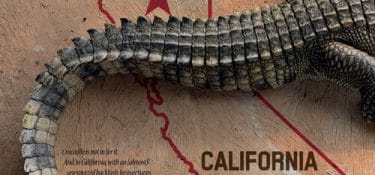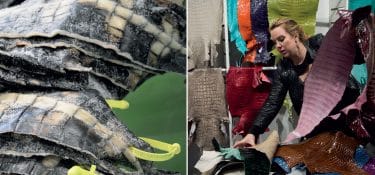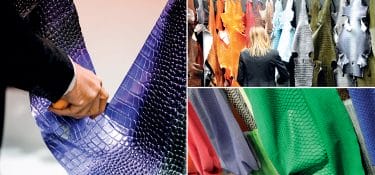Elvis & Kresse is a leather goods brand founded in 2015 in the United Kingdom with the Mission of re-using materials. Since 2017, the brand has partnered up with Burberry on a project that brings new life to the chain’s waste products
by Roberto Procaccini
The agreement
The agreement between Elvis & Kresse and Burberry, which became official in 2017, has a 5-year duration. The agreement establishes that 120 tons of leather by-products produced with the manufacturing process, be re-used, every year, to create accessories. The sale is conducted by Elvis & Kresse, while 50% of the profits will be donated to sustain renewable energy projects. Burberry’s ceo at the time, Christopher Bailey, commented: “Waste by-products are seen as worthless, but leather is a precious material”.
Sometimes industry operators discuss the matter of sustainability, in the fashion industry, in an almost over-complicated manner. Meaning: they start with complex theoretical thoughts, when to resolve the matter there are only (if we simplify the issue), practical solutions. Elvis & Kresse, English leather goods brand that, since it opened, has made circularity its goal and reason to exist, and has found the key to this reason behind the re-utilization of materials. The brand started by transforming the metallic part of firefighters’ hoses, into luxury accessories, and has enriched its resume by partnering with Burberry in fall of 2017, to work on a project that aims at recuperating the waste by-products of the leather chain. And, if one side, when thinking of this, asks itself “how do we manage to get the marketplace to understand and appreciate us?”, Elvis & Kresse verified that isn’t as hard as one may think, to successfully communicate the idea of a sustainable business: “we saved firefighters’ hoses, and donated 50% of the profits made from their sale to the Fire Fighters Charity – they explain to us -. We recuperate the leather that would go to waste, and transform it into components for the Fire & Hide collection, giving half of the profits to renewable energy projects. We already have a completely transparent lab, open to a continuous flux of visitors, that can learn how our value isn’t just in what we do, but also in how we do it. And we don’t expect our customers to pay more for this. We manufacture craftmanship accessories of high quality and our prices is, if we are being honest, lower than the reference segment”. The two founders, Elvis and Kresse, threw themselves in the fashion system without having a pedigree on the segment: the first one had experience as a project manager, while the other one had worked in venture capital funds on some green start-ups. Since 2017 the pair has worked on developing a plan to save leather waste by-products with Burberry Foundation. “We have recently passed the 1-year partnership mark, and all is proceeding well: we are reaching our primary goals – states Kresse -. We know that this joint operation can give a huge contribution to eliminating waste, and move towards a more circular economy. I believe that, like all entrepreneurs, we are never fully satisfied with our agenda: we want to do more and better. One of the wonderful things about this project is that we arranged it so that we can scale operations based on need: we can add part and create teams based on necessity. We can’t take all the leather at once, but we organized the plan so that the collections are scaled with regards to the moment”. The stylistic identity of this English brand doesn’t root its existence solely on leather, but its partnership with the historical co-national brand is inverting the trend: “Our first objective was that of re-using London’s firefighters’ hoes – continues Kresse -. Now we collect 15 different materials: some are natural, like leather, paper, and silk, while others aren’t, such as nylon and nitrile rubber. This is the first year in which we will use more leather than synthetic materials”. Elvis & Kresse puts its trust in an internal production chain, which function based on the quality and sustainability goals of the brand: “We conduct our business via 2 sites that are extremely connected to each other, one in London and one in Istanbul – explain the company’s representatives in the headquarter -. We prefer being in control of production because it means we have control over the treatment, economic and social, of the personnel. Moreover, internalizing means having the chance to completely eliminate plastic from production and opting for 100% of water-based adhesives”. At the antipodes of Elvis & Kresse’s cultural system there are two main elements. On the positive pole is the expansionary mentality: throughout the whole interview, Kresse repeats many times how the company wants to ‘do more’, (paraphrasing). On the other pole, there is the objective of bringing monetary success to the project. “At this point in time, it is very important for us to extend our partnership with Burberry and create long-lasting relationship along the entire leather chain – continues Kresse -. We have the potential to eliminate waste by-products from the chain, transforming them into something of value, environmentally, socially, and financially speaking. Leather swatches aren’t just an issue for the manufacturing company, because they are in fact an environmental issue, since 800,000 tons of them are created every year”. On the other hand, when asked what the company’s revenue and other financial aspects were performing, the founder prefers not to answer. “The reference parameter for our business is profit – she admits -, but this isn’t what we want to celebrate. We are a successful company because we have been able to consistently recuperate the materials that we don’t want to end up in landfills, beside from being able to increment our yearly charitable contributions. Have we always been growing? Yes. And the beauty is that our growth is based on the purchasing of larger quantities of material and larger donations to the causes that we support”. Elvis & Kresse intends to work with an ethical footprint: “Our growth creates more benefit, not more usage of precious resources or labor exploitation – concludes Kresse -. We are very proud to be a social enterprise and one of the founders of UK B-Corp (community of businesses with a certified sustainable practice). Everything is more interesting to us than profits”. Inevitably, we go back to the starting point: why is it so challenging, for some of the large brands in the fashion system, to be successful in this aspect, when a start-up founded in 2005 managed to reach success in less than 15 years? “Some still seem to think that sustainability is something to be discussed. But it isn’t a choice: it’s a duty – states Kresse -. The best thing to do is paying attention to the definition of “unsustainable”. According to the first two definitions given by Google, it means “not able to be maintained at the current rate or level” and “not able to be upheld or defended”. Ask any ceo if they believe that “unsustainable” is a business practice to keep their jobs”. Not all is lost, on the contrary: “The big news is that there is a lot of creativity that can be used to become sustainable – concludes Kresse -. It isn’t a depressing job: all those that want to come visit us to see how we work, or work with us, are welcome. We are happy to help”.
Big and small solutions
PETIT H
The intuition changed hands in 2010, when Pascale Mussard, descendant of Thierry Hermès, started running it. The manager posed herself questions regarding the leather-waste segment of the Leather Goods & Saddlery division of the French brand. What we are writing about is the circular re-using of waste by-products created during the manufacturing process, which was worth about 50% of the division’s total: 4.3 billion euro of revenue, in the first 9 months of 2018. Mussard answered her question by seeing the resource as something that could be used to create a collection that is oriented towards a more circular economy, Petit H. Main characteristic: it is made of unique accessories, given that production is subordinate to the availability of leather waste by-products supplied by Hermès. Petit H’s assortment goes from small necklaces to accessories. Ça va sans dire, ultra-luxury creations: a bag made with bovine and alligator leather sells for 9,000 euro. Mussard left the creative division of the brand in 2018. In her place, the designer that was already working with her, Godefroy de Virieu, was nominated to replace her.
EBARRITO
It appears to be a political slogan: “Ebarrito thinks intelligently: because it is isn’t disposable. But uses what has been thrown away, to create something unique, that can last in time. By re-using waste material, Ebarrito recycles and preserves the environment”. That is how Cremona-based brand, manufacturer of accessories, explains its philosophy to the public. And it works: the company closed 2017 with a revenue of 2 million euro. It was 300,000 in 2009.
REGENESI
In 2016, the company created a collection of accessories by re-using the leather of Dainese’s pilots’ overalls. In 2017 it did it once more with Lamborghini, crafting leather wallets and metallic components taken from super-cars. Regenesi is a Bologna-based company founded in 2008 with a strong eco-footprint: at the start of 2018, the owner Maria Silvia Pazzi, stated that she was looking for a partner that could assist the business in making that definitive qualitative jump forward.
AMERICAN TRAINS
Why would someone throw away all that leather in a landfill, even though it is at the end of its run? To avoid this wasteful action, Amtrak, US train operator, signed a partnership with the non-for-profit organization People for Urban Progress. The goal: to manufacture luxury handbags by re-using parts of seats that are no longer being used on trains. Thanks to the recovery of over 6,000 leather seat-covers from 20 wagons, it was possible to produce about 2,500 leather objects, handbags and backpacks: but everyone is different from the other, due to the imperfections of the original material.
FRENCH AIRPLANES
AirFrance was another company to present to market, in summer of 2017, a collection of handbags and accessories made with the seat-covers of airplanes seats no longer being used. The main material used for the collection is that of seats and headrests, hand-cut and properly cleaned, but the material did not undergo ulterior chemical treatments. In order to ensure success, the French company partnered with Bilum, maison born in 2005 with laboratories in Choisy-le-Roi, in Île-de-France.
MOTTA PELLI
“We realized that when we work on the pieces of leather that we showcase or sell to clients, we produce a large quantity of waste by-products, all of which tend to not be re-used, and thus must be disposed of. It is too bad: this waste is comprised of already-tanned leather, painted, and even those that have been treated a certain way”. Costanza Motta is the head of Research & Development of Monza-based tannery, Motta Pelli, a company founded in 1947 and of which she is the third generation. It was her idea to bring up this topic, and she explains the following: “We started making earrings out of the waste by-products that we produce. It seemed to me like the simplest and more fitting option, for the simple fact that the by-products are often very small and different in size. I also like the fact that, this way, we are using the waste product of another waste product, making us even more sustainable. The topic of the leather chain’s sustainability is often badly put”. Next step: “Increase the collection by adding necklaces and bracelets”. (lf)










